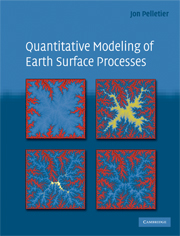Book contents
- Frontmatter
- Contents
- Preface
- Chapter 1 Introduction
- Chapter 2 The diffusion equation
- Chapter 3 Flow routing
- Chapter 4 The advection/wave equation
- Chapter 5 Flexural isostasy
- Chapter 6 Non-Newtonian flow equations
- Chapter 7 Instabilities
- Chapter 8 Stochastic processes
- Appendix 1 Codes for solving the diffusion equation
- Appendix 2 Codes for flow routing
- Appendix 3 Codes for solving the advection equation
- Appendix 4 Codes for solving the flexure equation
- Appendix 5 Codes for modeling non-Newtonian flows
- Appendix 6 Codes for modeling instabilities
- Appendix 7 Codes for modeling stochastic processes
- References
- Index
- Plate section
Chapter 6 - Non-Newtonian flow equations
Published online by Cambridge University Press: 05 June 2012
- Frontmatter
- Contents
- Preface
- Chapter 1 Introduction
- Chapter 2 The diffusion equation
- Chapter 3 Flow routing
- Chapter 4 The advection/wave equation
- Chapter 5 Flexural isostasy
- Chapter 6 Non-Newtonian flow equations
- Chapter 7 Instabilities
- Chapter 8 Stochastic processes
- Appendix 1 Codes for solving the diffusion equation
- Appendix 2 Codes for flow routing
- Appendix 3 Codes for solving the advection equation
- Appendix 4 Codes for solving the flexure equation
- Appendix 5 Codes for modeling non-Newtonian flows
- Appendix 6 Codes for modeling instabilities
- Appendix 7 Codes for modeling stochastic processes
- References
- Index
- Plate section
Summary
Introduction
Chapter 1 introduced the concept of non- Newtonian fluids and highlighted their importance for our understanding of the mechanics of glaciers. In this chapter we explore methods for modeling non-Newtonian fluids with applications to ice sheets, glaciers, lava flows, and thrust sheets. In most cases we will make the simplifying assumption that the rheology of the flow is constant in time. In nature, however, many types of non-Newtonian flows are complicated by the fact that the rheology of the flow depends on parameters that evolve with the flow itself. The viscosity of lava, for example, depends on its temperature, which, in turn, depends on the flow behavior (e.g. slower moving lava will cool more quickly, increasing its viscosity and further slowing flow in a positive feedback). Here we focus primarily on modeling flows with a constant, prescribed rheology. In cases where the rheology depends strongly on the state of the flow the methods introduced in this chapter will serve as the foundation for more complex models which fully couple the rheology with the flow.
Modeling non-Newtonian and perfectly plastic flows
First we consider the forces acting on a fluid spreading over a flat surface (Figure 6.1). We begin with a 1D example, so the fluid is assumed to extend infinitely far into and out of the cross section. The horizontal force F exerted on the left side of a thin vertical slice of the fluid of width Δx is equal to the total hydrostatic pressure in the fluid column.
- Type
- Chapter
- Information
- Quantitative Modeling of Earth Surface Processes , pp. 125 - 160Publisher: Cambridge University PressPrint publication year: 2008



